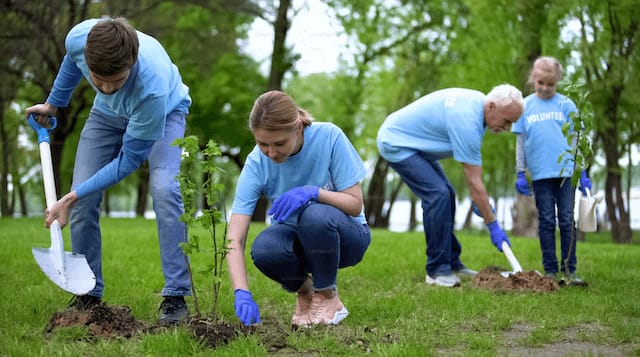- Tapestry
- Posts
- The Gift of You
The Gift of You
Be a hero
Hello, dear readers. In this issue:
Why giving matters
The many forms of philanthropy
Bake sales and recipes
A final thought on giving
Why giving matters
When you give of yourself, your act of kindness is like a pebble in a pond. It ripples out in every direction to touch lives in meaningful ways, while instilling hope where it’s needed and inspiring others to give.
Philanthropy and volunteerism have the power to bring people together, and to foster camaraderie and trust. Beyond that, it provides volunteers with a sense of purpose, fulfillment, and enhanced mental and physical well-being.

That “feel-good” feeling
When you donate your time or make a financial contribution, your health gets something in return.
It's a very real phenomenon that scientists refer to as the "helper's high." Simply put, your body produces feel-good chemicals that boost your mood. Studies show that older adults who volunteer tend to have lower blood pressure, fewer symptoms of depression, and may even live longer. Many volunteers and philanthropists also share a renewed sense of purpose and belonging.

Whether you decide to retire or rewire, there may be times when you feel isolated, particularly if you enjoyed close relationships with your coworkers. Volunteering puts you in the middle of the action with people who share your interests and concerns. That creates pathways to building new friendships and connections that make life richer.
Your brain benefits too. Staying involved keeps your mind sharp. You're solving problems, organizing events, learning new things—all the mental exercise that helps keep you feeling younger and more capable.
Volunteering often gives you a profound sense of purpose. After spending years building a career, it's reassuring to have a place where you feel like you fit in. Giving back lets you use your experience and wisdom while continuing to grow and learn.

The many forms of philanthropy
Getting involved with meaningful activities can go a long way to broaden your horizons – often without a financial commitment. These acts of generosity often address root causes of inequality while building connections and empowering people with tools for long-term gain:
Share skills and knowledge. Mentor or tutor young people, teach practical skills like cooking or budgeting to community members, or offer career guidance to job seekers.
Support vulnerable populations. Visit residents at nursing homes or assisted living facilities. Read to children at libraries or daycares, help with basic computer skills training, or tax preparation if experienced.
Join community support activities. Organize neighborhood clothing or food drives for local shelters, assist with voter registration, or hold a bake sale to benefit a group in need.
Direct service opportunities. Volunteer at food banks or soup kitchens, help with administrative tasks at nonprofits, assist at animal shelters, or work at local libraries to help with shelving and programs.
Use your creativity. Make blankets, hats, or scarves for people experiencing homelessness; join a holiday gift wrap program at a local mall or shopping center.
Creative and arts-based services. Bring your artistic skills to underserved schools, community centers, or senior facilities. Preserve cultural heritage by collecting oral histories from older adults.
Digital equity. Bridge the digital divide by refurbishing donated computers for low-income families, teaching smartphone basics, or helping job seekers complete applications and improve their digital literacy.
Environmental justice projects. Support community gardens in food deserts, organize neighborhood cleanup efforts, or help establish composting programs in residential communities.
Economic empowerment. Mentor small business owners, do basic bookkeeping, or help others navigate government programs like healthcare enrollment or social services applications.
Food inequity. Support community fridges and Little Free Pantries by stocking, maintaining, and organizing these grassroots hunger relief efforts. Participate in food drives.

Bake sales
Who doesn’t love a good bake sale. And why not? It's a simple, effective way to raise money at a minimal cost and bring smiles to many faces. It can be a chance to engage and meet new friends, too.
Before starting, check your local health codes and cottage food laws.
Start organizing by recruiting volunteers and setting clear fundraising goals.
Choose a busy location and time for your sale, perhaps during a holiday or community event.
Offer variety, with options for dietary restrictions, and promote your sale through posters and social media.
Use colorful decorations and individually wrapped goods.
Always pre-package items with ingredient labels, maintain contributor records, and ensure all bakers follow proper hygiene practices.
Price items in whole dollars; accept cash and digital payments, e.g. Zelle or Venmo
What to bake? Brownies of all descriptions are surefire winners. My hands-down favorite is Katherine Hepburn’s brownies – these are decadent, fudgy, and best of all, so easy.
Here are some great recipe collections for your bake sale:
Bake Sale Ideas for Kids (adults will love these, too!)

What did you think of this week's newsletter? |
Reply to this newsletter with any other feedback. We read and respond to every email.

A final thought on giving

“A sense of concern for others gives our lives meaning; it is the root of all human happiness.”
- Dalai Lama
We look forward to building this tapestry of experiences with you.



Social and cognitive benefits